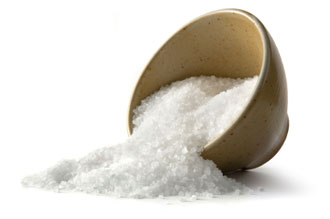 Because you didn’t have enough on your plate, life with Postural Orthostatic Tachycardia Syndrome also includes a multitude of strange and unpredictable stomach woes.
Because you didn’t have enough on your plate, life with Postural Orthostatic Tachycardia Syndrome also includes a multitude of strange and unpredictable stomach woes.Just about everything in a POTS patient’s diet is unfamiliar to most spectators—from the high sodium loading to the endless fluids, this disease can be one of extremes.
What’s With the Salt?
While you’ve certainly heard that lowering one’s salt intake has significant benefits, actually raising the salt intake for a POTS patient can help manage symptoms. According to Dysautonomia international, “it is often recommended to increase both fluid and salt intake in order to increase blood volume, which is typically low in POTS patients. This has proven to be particularly helpful in patients with blood pooling, hypovolemia, or hypotension.”
So what kind of foods can patients eat to get just enough salt in their diet?
Just a few include
· Canned Soups
· Sports Drinks, such as Pedialyte
· Kosher Meats
· Cereals
· Vegetable Juices
· Canned Vegetables
· Soy Sauce
· Canned Spaghetti Sauce
· Nuts
Many patients find themselves suffering from a condition called Gastroparesis.
Gastroparesis, also called delayed gastric emptying, is a disorder that slows or stops the movement of food from the stomach to the small intestine. Normally, the muscles of the stomach, which are controlled by the vagus nerve, contract to break up food and move it through the gastrointestinal (GI) tract. The GI tract is a series of hollow organs joined in a long, twisting tube from the mouth to the anus. The movement of muscles in the GI tract, along with the release of hormones and enzymes, allows for the digestion of food. Gastroparesis can occur when the vagus nerve is damaged by illness or injury and the stomach muscles stop working normally. Food then moves slowly from the stomach to the small intestine or stops moving altogether. (NDDIC)

Patients may also experience malnourishment. This is a condition that results from eating a diet that lacks certain nutrients, has others in excess, or are eaten in the wrong proportion. Though most often seen in undeveloped countries, malnutrition can be found in places like North America due to not eating enough good, or eating food of poor quality. Because POTS patients experience intolerances to many foods, they can lack the basic nutrition they need for their body to function.
Here is a “cheat sheet” of what may be causing malnourishment in patients.
|
A Diet Low in This Vitamin
|
May Produce These Signs of Deficiency
|
| Vitamin A | Poor night vision; dry, rough, or cracked skin; drymucous membranes including the inside of the eye; slow wound healing; nerve damage; reduced ability to taste, hear, and smell; inability to perspire; reduced resistance to respiratory infections |
| Vitamin D |
In children: rickets (weak muscles, delayed tooth development, and soft bones, all caused by the inability to absorb minerals without vitamin D)
In adults: osteomalacia (soft, porous bones that fracture easily)
|
| Vitamin E | Inability to absorb fat |
| Vitamin K | Blood fails to clot |
| Vitamin C | Scurvy (bleeding gums; tooth loss; nosebleeds; bruising; painful or swollen joints; shortness of breath; increased susceptibility to infection; slow wound healing; muscle pains; skin rashes) |
| Thiamin(vitamin B1) | Poor appetite; unintended weight loss; upset stomach; gastric upset (nausea, vomiting); mental depression; an inability to concentrate |
| Riboflavin(vitamin B2) | Inflamed mucous membranes, including cracked lips, sore tongue and mouth, burning eyes; skin rashes; anemia |
| Niacin | Pellagra (diarrhea; inflamed skin and mucous membranes; mental confusion and/or dementia) |
| Vitamin B6 | Anemia; convulsions similar to epileptic seizures; skin rashes; upset stomach; nerve damage (in infants) |
| Folate | Anemia (immature red blood cells) |
| Vitamin B12 | Pernicious anemia (destruction of red blood cells, nerve damage, increased risk of stomach cancer attributed to damaged stomach tissue, neurological/psychiatric symptoms attributed to nerve cell damage) |
| Biotin | Loss of appetite; upset stomach; pale, dry, scaly skin; hair loss; emotional depression; skin rashes (in infants younger than 6 months) |
(source)
Patients should also be aware of whether or not they’re getting enough protein. Fish can be an excellent source, low in fat and full of omega-3 fatty acids. Chicken (white meat) is a good lean protein that can be salted for flavor. Many POTS patients with gastroparesis may have difficulty with lactose, but there are many high-protein, lactose free options now on the market.
Most importantly, it’s a good idea for patients to try new foods to continue to add diversity to their diets.